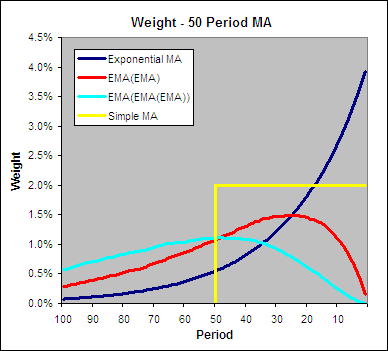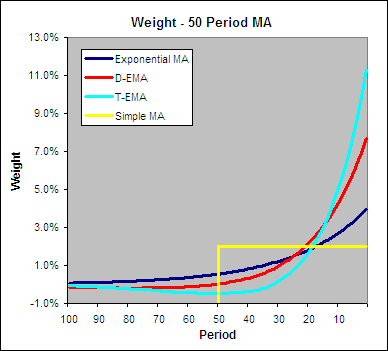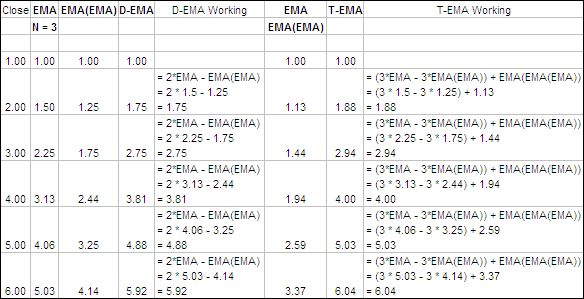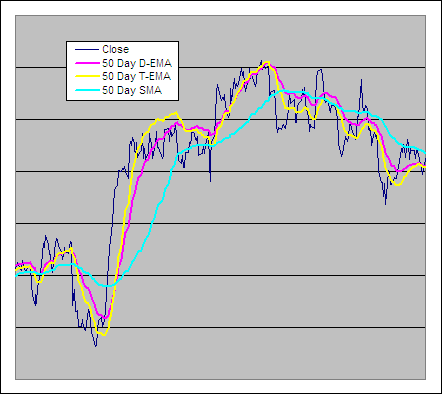The Double and Triple Exponential Moving Average were created by Patrick Mulloy and first published in the February 1994 issue of Technical Analysis of Stocks & Commodities magazine – Smoothing Data With Less Lag. Mulloy stated in his article:
.
“Moving averages have a detrimental lag time that increases as the moving average length increases. The solution is a modified version of exponential smoothing with less lag time.”
.
Like an EMA, the D-EMA and T-EMA apply more weight to the most recent data in an attempt to smooth out noise while still remaining highly reactive to changes in the data. This is not achieved by simply double and triple smoothing as one may assume. To do so results in weighting that resembles a backwards log-normal distribution, rather like a Triangular Moving Average but smooth and shifted forward. Below you can see how the weighting is allocated by a single, double and triple smoothed exponential moving average compared to a standard EMA and SMA:
.
 .
.
As you can see by double and triple smoothing an EMA the weighting no longer focuses on the latest data. The actual Double and Triple Exponential Moving Average applies the weighing very heavily to the most recent data as illustrated in the chart below:
.

.
How To Calculate a Double Exponential Moving Average and T-EMA
.
Double Exponential MA Formula:
D-EMA = 2*EMA – EMA(EMA)
Triple Exponential MA Formula:
T-EMA = (3*EMA – 3*EMA(EMA)) + EMA(EMA(EMA))
Where:
EMA = EMA(1) + α * (Close – EMA(1))
α = 2 / (N + 1)
N = The smoothing period.
Here is an example of a 3 period Double Exponential Moving Average and Triple EMA:
.
 .
.
Triple Exponential Moving Average and D-EMA Excel File
.
We have built a spreadsheet to calculate the D-EMA and T-EMA and have made it available for free download. Find the file at the following link near the bottom of the page under Downloads – Technical Indicators: Double (D-EMA) and Triple Exponential Moving Average (T-EMA).
.
Double EMA, Triple EMA and a Simple Moving Average
.
 .
.
Double and Triple Exponential Moving Average Test Results
We ran them through tests through over 300 years of data across 16 different global markets. Here are the results:
Double Exponential Moving average Vs Simple and Exponential Moving average
Double Vs Triple Exponential Moving Average
More in this series:
We have conducted and continue to conduct extensive tests on a variety of technical indicators. See how they perform and which reveal themselves as the best in the Technical Indicator Fight for Supremacy.
This is intelligent , good . stuff !! It’s makes a lot of sense to avoid false signals and opposite
calls — like opposire polarity in series resonant circuits —
what is EMA(EMA) ??
Hi Hobart,
Thanks for your question. It is an Exponential Moving Average applied to the Exponential Moving Average.
Cheers
Derry